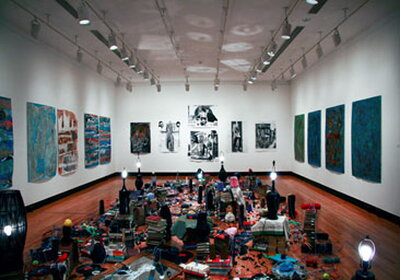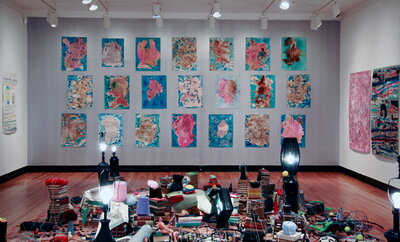
Moshekwa Langa at the Krannert Art Museum
by Ashley E. Sheriff
Photo Courtesy Krannert Museum

Contemporary artist Moshekwa Langa’s installation Counterpoints: Mogalakwena is on display at the Krannert Art Museum until July 28, 2013. Brightly colored abstract paintings and collages line the walls of the gallery space, but the floor takes center stage as a brilliantly arranged cityscape populated with odds-and-ends of scratched vinyl albums, tattered books, naked dolls, unshaded lamps and leagues of impossibly tangled yarn that connect a myriad of secondhand landmarks. Langa explains that it reflects on a landscape “that has been scorched or burned with the possibility of renewal.” This work represents the end of an epoch in Langa’s life, closing his time in South Africa. Langa was born in Bakenburg, South Africa in 1975, left in 1993 for a residency in Berlin and currently lives in Amsterdam. Although Langa says his art does not address political issues as such, the installation’s disorienting setting, much like the South African political and social landscape “is not free of interferences – of hurdles.”

Photo Courtesy Krannert Art Museum
This motley collection of objects was the result of nearly a week of shopping, collecting and installing by Langa and Dr. Allyson Purpura, who curated the exhibit. Aside from Langa’s own paintings and intricate collages, Purpura and Langa collected all the objects used in the installation locally from Champaign-Urbana based libraries and shops, including the University of Illinois and Urbana Free libraries, flea markets, Goodwill, Habitat for Humanity, and the I.D.E.A. Langa was installing up to the day before the opening on January 25, 2013.
Much of Langa’s work is somewhat autobiographical; he reconstructs and reinterprets his most intimate experiences through art. Although many installations are colorful, playful and whimsical, they are oftentimes weighted with personal history and uncomfortable narratives. Many of his pieces are stylized fragments of his memories, but numerous others are just the unusual results of making art out of serendipitous discoveries. Langa brilliantly incorporates incidental and unintentional constructions in his artwork and experiments with the distinctive colors that ordinary liquids and household items such as coffee, tea and red wine produce when applied to differently textured surfaces. According to Purpura, he is also interested in things that draw visitors into the landscapes he creates; audiences re-interpret his installation, internalize it, and inhabit it. His art creates a definite sense of emplacement as well as displacement.

Photo Courtesy Krannert Art Museum
Story-boards, landscapes, and detailed collages of maps and place-names characterize much of Langa’s artworks. Perhaps he still clings to a very personal, poignant experience in his elementary school geography class in which his instructor asked the class to create an atlas of where they lived. At that time in Apartheid South Africa, Bakenberg was a semi-independent homeland with no nationally recognized landmarks – and in fact, was not on the South African atlases used in his school. “I felt like a country bumpkin” Langa said, “and the other students did not shy away from reminding me.” His contemporaries chided him by telling him that his home did not exist – simply because it was not in official South African records. Langa soothed his feelings by piecing together fragments of fairytales and wrote them into his own atlas. “I tried to write the story of Moshekwa,” Langa said during his lecture on February 21st at Artist’s Talk, sponsored by the Krannert Art Museum. Langa describes his current work as rough and expressionistic, but perhaps his art is motivated by a deeper theme, an “insistence on his own presence,” Purpura said.